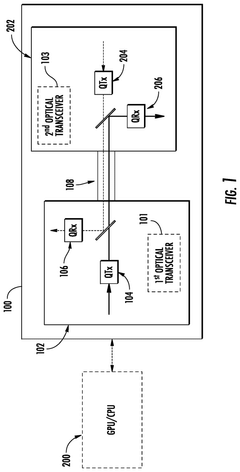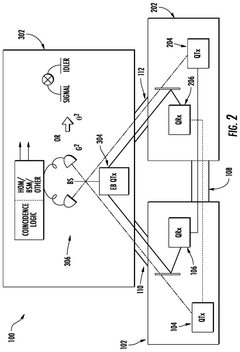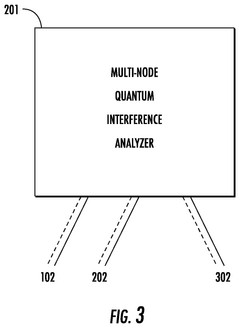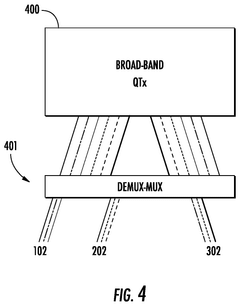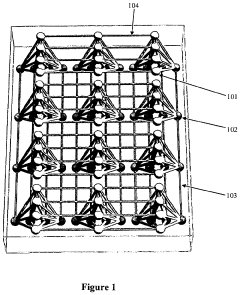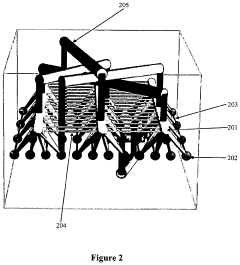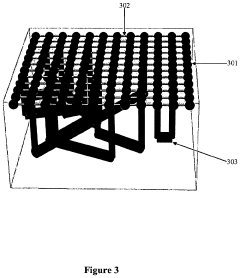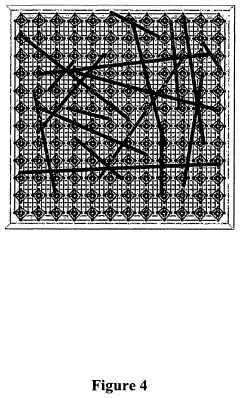Comparison of Quantum Interconnects vs Classical Interconnects
SEP 29, 202510 MIN READ
Generate Your Research Report Instantly with AI Agent
Patsnap Eureka helps you evaluate technical feasibility & market potential.
Quantum vs Classical Interconnect Evolution
The evolution of interconnect technologies represents a critical aspect of computing system development, with classical interconnects serving as the foundation for decades. Classical interconnects have evolved from simple copper wires to sophisticated multi-layer systems, following Moore's Law with consistent improvements in bandwidth, latency, and energy efficiency. This evolution has been marked by transitions from parallel buses to serial links, and from electrical to optical interconnects to overcome physical limitations.
The timeline of classical interconnect evolution shows distinct phases: early computing systems (1950s-1970s) utilized simple point-to-point connections with limited bandwidth; the standardization era (1980s-1990s) introduced protocols like PCI and Ethernet; the high-speed serial era (2000s-2010s) brought PCIe, InfiniBand, and high-speed Ethernet; and the current advanced interconnect era features technologies like NVLink, CXL, and silicon photonics.
Quantum interconnects represent a paradigm shift, emerging from theoretical concepts to experimental implementations over the past two decades. Unlike classical interconnects that transmit binary data, quantum interconnects must preserve quantum states and handle quantum information's unique properties, including superposition and entanglement. The evolution began with short-distance quantum state transfers in the early 2000s, followed by quantum repeater concepts to address decoherence challenges.
Recent years have witnessed significant breakthroughs in quantum interconnect technologies, including satellite-based quantum key distribution demonstrations by China's Micius satellite in 2017, entanglement distribution over fiber networks exceeding 100km, and the development of quantum memory interfaces. The convergence of classical and quantum interconnects is becoming increasingly important as hybrid quantum-classical systems emerge as the practical architecture for near-term quantum computing applications.
The fundamental differences in information handling between classical and quantum interconnects drive their divergent evolutionary paths. Classical interconnects focus on increasing bandwidth and reducing latency while maintaining signal integrity, whereas quantum interconnects prioritize maintaining quantum coherence, enabling entanglement distribution, and developing quantum repeater technologies to overcome distance limitations.
The future evolution trajectory suggests continued specialization in classical interconnects with increased adoption of silicon photonics and novel materials, while quantum interconnects will likely focus on improving fidelity, distance, and integration with classical networks to create functional quantum networks capable of supporting distributed quantum computing and quantum internet applications.
The timeline of classical interconnect evolution shows distinct phases: early computing systems (1950s-1970s) utilized simple point-to-point connections with limited bandwidth; the standardization era (1980s-1990s) introduced protocols like PCI and Ethernet; the high-speed serial era (2000s-2010s) brought PCIe, InfiniBand, and high-speed Ethernet; and the current advanced interconnect era features technologies like NVLink, CXL, and silicon photonics.
Quantum interconnects represent a paradigm shift, emerging from theoretical concepts to experimental implementations over the past two decades. Unlike classical interconnects that transmit binary data, quantum interconnects must preserve quantum states and handle quantum information's unique properties, including superposition and entanglement. The evolution began with short-distance quantum state transfers in the early 2000s, followed by quantum repeater concepts to address decoherence challenges.
Recent years have witnessed significant breakthroughs in quantum interconnect technologies, including satellite-based quantum key distribution demonstrations by China's Micius satellite in 2017, entanglement distribution over fiber networks exceeding 100km, and the development of quantum memory interfaces. The convergence of classical and quantum interconnects is becoming increasingly important as hybrid quantum-classical systems emerge as the practical architecture for near-term quantum computing applications.
The fundamental differences in information handling between classical and quantum interconnects drive their divergent evolutionary paths. Classical interconnects focus on increasing bandwidth and reducing latency while maintaining signal integrity, whereas quantum interconnects prioritize maintaining quantum coherence, enabling entanglement distribution, and developing quantum repeater technologies to overcome distance limitations.
The future evolution trajectory suggests continued specialization in classical interconnects with increased adoption of silicon photonics and novel materials, while quantum interconnects will likely focus on improving fidelity, distance, and integration with classical networks to create functional quantum networks capable of supporting distributed quantum computing and quantum internet applications.
Market Demand Analysis for Quantum Interconnect Solutions
The quantum interconnect market is experiencing significant growth driven by the rapid advancement of quantum computing technologies. Current market analysis indicates a growing demand for quantum interconnect solutions across various sectors, particularly in research institutions, technology companies, and government agencies investing in quantum computing infrastructure. This demand is primarily fueled by the limitations of classical interconnects when applied to quantum systems, which require fundamentally different approaches to maintain quantum coherence and entanglement.
Financial institutions and pharmaceutical companies are emerging as key market segments with substantial interest in quantum interconnect solutions. These sectors recognize the potential of quantum computing for complex simulations and data analysis that could revolutionize their operations. Market research suggests that early adopters are willing to invest significantly in quantum interconnect technologies that can demonstrate clear advantages over classical alternatives in terms of maintaining quantum states and enabling scalable quantum computing architectures.
The market for quantum interconnect solutions is projected to grow alongside the broader quantum computing market. Industry analysts note that as quantum computers move beyond the noisy intermediate-scale quantum (NISQ) era toward fault-tolerant systems, the demand for reliable quantum interconnects will increase exponentially. This transition represents a critical inflection point for market expansion.
Regional analysis reveals varying levels of market readiness and investment. North America currently leads in quantum interconnect research and development, with significant investments from both private and public sectors. Europe follows closely, with strong academic-industrial partnerships driving innovation. The Asia-Pacific region is rapidly accelerating its quantum initiatives, with substantial government backing in China, Japan, and Singapore.
Customer requirements for quantum interconnect solutions differ markedly from classical interconnect markets. End-users prioritize quantum coherence preservation, entanglement distribution capabilities, and compatibility with existing quantum computing platforms. There is also growing demand for hybrid solutions that can effectively bridge classical and quantum computing environments during the transition period.
Market barriers include the high cost of development, technical complexity, and the specialized expertise required for implementation. Despite these challenges, venture capital funding for quantum interconnect startups has increased, indicating strong market confidence in the long-term potential of these technologies.
Industry surveys indicate that potential customers are particularly interested in quantum interconnect solutions that address specific pain points: reducing decoherence, enabling distributed quantum computing, and facilitating quantum-secure communications. These market signals suggest that targeted solutions addressing these specific needs may find earlier commercial success than general-purpose approaches.
Financial institutions and pharmaceutical companies are emerging as key market segments with substantial interest in quantum interconnect solutions. These sectors recognize the potential of quantum computing for complex simulations and data analysis that could revolutionize their operations. Market research suggests that early adopters are willing to invest significantly in quantum interconnect technologies that can demonstrate clear advantages over classical alternatives in terms of maintaining quantum states and enabling scalable quantum computing architectures.
The market for quantum interconnect solutions is projected to grow alongside the broader quantum computing market. Industry analysts note that as quantum computers move beyond the noisy intermediate-scale quantum (NISQ) era toward fault-tolerant systems, the demand for reliable quantum interconnects will increase exponentially. This transition represents a critical inflection point for market expansion.
Regional analysis reveals varying levels of market readiness and investment. North America currently leads in quantum interconnect research and development, with significant investments from both private and public sectors. Europe follows closely, with strong academic-industrial partnerships driving innovation. The Asia-Pacific region is rapidly accelerating its quantum initiatives, with substantial government backing in China, Japan, and Singapore.
Customer requirements for quantum interconnect solutions differ markedly from classical interconnect markets. End-users prioritize quantum coherence preservation, entanglement distribution capabilities, and compatibility with existing quantum computing platforms. There is also growing demand for hybrid solutions that can effectively bridge classical and quantum computing environments during the transition period.
Market barriers include the high cost of development, technical complexity, and the specialized expertise required for implementation. Despite these challenges, venture capital funding for quantum interconnect startups has increased, indicating strong market confidence in the long-term potential of these technologies.
Industry surveys indicate that potential customers are particularly interested in quantum interconnect solutions that address specific pain points: reducing decoherence, enabling distributed quantum computing, and facilitating quantum-secure communications. These market signals suggest that targeted solutions addressing these specific needs may find earlier commercial success than general-purpose approaches.
Current State and Technical Challenges of Quantum Interconnects
Quantum interconnects currently exist in a nascent state compared to their classical counterparts. While classical interconnects have benefited from decades of refinement in the semiconductor industry, quantum interconnects are still primarily confined to laboratory environments. The fundamental challenge lies in maintaining quantum coherence across distances, as quantum states are extremely fragile and susceptible to decoherence from environmental interactions.
Current implementations of quantum interconnects primarily utilize three approaches: optical fiber-based systems for photonic qubits, superconducting transmission lines for superconducting qubits, and direct shuttling of trapped ions. Each approach faces significant technical limitations. Optical systems struggle with conversion efficiency between quantum processors and photonic states, typically achieving only 10-30% efficiency. Superconducting transmission lines require cryogenic temperatures below 100 mK and can only maintain coherence over distances of a few centimeters.
Geographically, quantum interconnect research is concentrated in North America, Europe, and Asia, with notable centers including MIT, Delft University of Technology, and the University of Science and Technology of China. The field remains highly academic, though companies like IBM, Google, and Alibaba have begun investing in proprietary quantum networking technologies.
A critical technical challenge is the quantum-classical interface, where quantum information must be reliably transferred to classical systems for processing or vice versa. Current solutions achieve this with fidelities ranging from 85-95%, still below the threshold required for fault-tolerant quantum computing (typically >99%).
Scalability presents another significant hurdle. While laboratory demonstrations have shown quantum state transfer between nodes separated by up to 50 kilometers using quantum repeaters, creating networks with multiple nodes remains extremely difficult due to exponentially increasing complexity in maintaining multi-node entanglement.
Error correction for quantum interconnects introduces additional complexity beyond that required for isolated quantum processors. Current quantum error correction codes for interconnects require substantial overhead, often needing 10-100 physical qubits to encode a single logical qubit during transmission.
Material science limitations also constrain progress, as interfaces between different quantum systems (such as superconducting qubits and optical photons) require novel materials with precisely engineered properties. Current materials achieve conversion efficiencies below 50% and introduce significant noise into the quantum signal.
Despite these challenges, recent breakthroughs in quantum memory technologies and the demonstration of elementary quantum networks with 3-5 nodes suggest that functional quantum interconnects may become viable for specialized applications within the next 5-10 years, though general-purpose quantum networking remains a longer-term prospect.
Current implementations of quantum interconnects primarily utilize three approaches: optical fiber-based systems for photonic qubits, superconducting transmission lines for superconducting qubits, and direct shuttling of trapped ions. Each approach faces significant technical limitations. Optical systems struggle with conversion efficiency between quantum processors and photonic states, typically achieving only 10-30% efficiency. Superconducting transmission lines require cryogenic temperatures below 100 mK and can only maintain coherence over distances of a few centimeters.
Geographically, quantum interconnect research is concentrated in North America, Europe, and Asia, with notable centers including MIT, Delft University of Technology, and the University of Science and Technology of China. The field remains highly academic, though companies like IBM, Google, and Alibaba have begun investing in proprietary quantum networking technologies.
A critical technical challenge is the quantum-classical interface, where quantum information must be reliably transferred to classical systems for processing or vice versa. Current solutions achieve this with fidelities ranging from 85-95%, still below the threshold required for fault-tolerant quantum computing (typically >99%).
Scalability presents another significant hurdle. While laboratory demonstrations have shown quantum state transfer between nodes separated by up to 50 kilometers using quantum repeaters, creating networks with multiple nodes remains extremely difficult due to exponentially increasing complexity in maintaining multi-node entanglement.
Error correction for quantum interconnects introduces additional complexity beyond that required for isolated quantum processors. Current quantum error correction codes for interconnects require substantial overhead, often needing 10-100 physical qubits to encode a single logical qubit during transmission.
Material science limitations also constrain progress, as interfaces between different quantum systems (such as superconducting qubits and optical photons) require novel materials with precisely engineered properties. Current materials achieve conversion efficiencies below 50% and introduce significant noise into the quantum signal.
Despite these challenges, recent breakthroughs in quantum memory technologies and the demonstration of elementary quantum networks with 3-5 nodes suggest that functional quantum interconnects may become viable for specialized applications within the next 5-10 years, though general-purpose quantum networking remains a longer-term prospect.
Existing Quantum and Classical Interconnect Solutions
01 Quantum interconnect performance advantages over classical systems
Quantum interconnects offer significant performance advantages over classical interconnects, particularly in terms of data transfer rates and reduced latency. These interconnects leverage quantum entanglement and superposition to transmit information more efficiently than classical systems. The quantum approach enables simultaneous processing of multiple states, providing exponential speedup for certain computational tasks compared to classical interconnects that are limited by physical transmission constraints.- Performance metrics and benchmarking of quantum vs classical interconnects: Comparative analysis of quantum and classical interconnects focuses on key performance metrics including latency, bandwidth, scalability, and energy efficiency. Quantum interconnects demonstrate advantages in certain computational tasks due to quantum entanglement and superposition properties, while classical interconnects currently offer greater reliability and established infrastructure. Benchmarking methodologies have been developed to evaluate performance across different workloads and system architectures, providing quantitative measures for comparison.
- Quantum communication protocols and their advantages over classical networks: Quantum communication protocols leverage quantum properties like entanglement to achieve capabilities impossible in classical networks, such as quantum key distribution for unconditionally secure communications. These protocols can potentially overcome bandwidth limitations of classical interconnects through quantum teleportation and dense coding. While classical networks are limited by the speed of light and face security vulnerabilities, quantum networks offer theoretical advantages in information density and security guarantees, though they currently face significant implementation challenges.
- Hybrid quantum-classical interconnect architectures: Hybrid architectures combine quantum and classical interconnect technologies to leverage the strengths of both approaches. These systems typically use classical networks for control operations and data preprocessing, while employing quantum channels for specific computational tasks that benefit from quantum advantages. The integration requires specialized interfaces and protocols to translate between quantum and classical information domains. Hybrid approaches represent a practical near-term solution that addresses the current limitations of fully quantum systems while still providing performance improvements for certain applications.
- Error correction and fault tolerance in quantum vs classical interconnects: Error correction mechanisms differ significantly between quantum and classical interconnects. Classical systems use established error correction codes with relatively low overhead, while quantum interconnects require more complex quantum error correction techniques to protect against decoherence and quantum noise. Fault tolerance in quantum systems typically demands significantly more physical resources than classical counterparts, impacting overall system performance. The error rates and correction capabilities represent a critical factor in performance comparisons, with quantum systems currently facing greater challenges in maintaining data integrity across interconnects.
- Scalability and resource requirements comparison: Scalability presents different challenges for quantum and classical interconnects. Classical interconnects benefit from decades of engineering optimization but face physical limitations as dimensions shrink. Quantum interconnects offer theoretical advantages in information density but currently require extensive physical infrastructure including cryogenic cooling systems and precise control electronics. Resource requirements for quantum systems typically scale exponentially with the number of qubits, while classical systems follow more favorable scaling laws. This fundamental difference impacts the practical deployment and performance of large-scale interconnect systems.
02 Hybrid quantum-classical interconnect architectures
Hybrid architectures that combine quantum and classical interconnects offer practical solutions for near-term quantum computing systems. These designs leverage the strengths of both paradigms, using classical interconnects for control operations and system management while employing quantum channels for high-performance data processing. The hybrid approach addresses current limitations in fully quantum systems while providing performance improvements over purely classical implementations, particularly for specific computational workloads.Expand Specific Solutions03 Scalability comparison between quantum and classical interconnects
Quantum interconnects demonstrate superior scalability characteristics compared to classical interconnects when handling complex computational problems. While classical interconnects face bandwidth and power consumption limitations as system size increases, quantum interconnects can maintain performance through entanglement-based communication protocols. This fundamental difference allows quantum systems to scale more efficiently for certain applications, though they currently face practical implementation challenges related to qubit coherence and error correction that impact real-world scalability.Expand Specific Solutions04 Error rates and fault tolerance in quantum versus classical interconnects
Quantum interconnects currently exhibit higher error rates compared to mature classical interconnect technologies, presenting a significant performance challenge. Classical interconnects benefit from decades of engineering refinement with established error correction protocols, while quantum systems are more susceptible to environmental interference and decoherence. Advanced quantum error correction techniques are being developed to address these limitations, but they require additional qubits and processing overhead that impacts overall system performance when comparing the two interconnect paradigms.Expand Specific Solutions05 Energy efficiency comparison between quantum and classical interconnects
Quantum interconnects potentially offer superior energy efficiency compared to classical interconnects for specific computational tasks. Classical interconnects consume energy proportional to the amount of data transferred and distance covered, while quantum interconnects can theoretically transmit complex states with lower energy requirements through quantum teleportation and entanglement-based protocols. However, current quantum systems require extensive cooling infrastructure and control electronics that significantly increase their overall energy footprint, making practical energy efficiency comparisons highly dependent on the specific application and implementation.Expand Specific Solutions
Key Industry Players in Quantum Interconnect Development
The quantum interconnect market is in an early growth phase, characterized by significant research and development activities but limited commercial deployment. The market size is projected to expand rapidly as quantum computing transitions from research to practical applications, with estimates suggesting a multi-billion dollar opportunity by 2030. Technologically, quantum interconnects remain less mature than classical counterparts, with companies at varying stages of development. IBM leads with significant quantum networking advancements and integration capabilities, while Google and Intel are leveraging their classical interconnect expertise to develop quantum solutions. Specialized quantum companies like IonQ, PsiQuantum, and Origin Quantum are focusing on specific quantum interconnect technologies, with photonic approaches (championed by PsiQuantum and Photonic Inc.) showing particular promise for long-distance quantum communication. Academic-industry partnerships are accelerating development across both classical and quantum domains.
International Business Machines Corp.
Technical Solution: IBM has pioneered quantum interconnect technologies through their Quantum System One and subsequent systems. Their approach focuses on superconducting qubit architecture with specialized cryogenic interconnects that maintain quantum coherence. IBM's quantum fabric interconnect technology enables qubit communication across multiple quantum processing units while minimizing decoherence effects. Their latest developments include the implementation of quantum communication protocols that allow for distributed quantum computing across physically separated quantum processors. IBM has also developed specialized control electronics that bridge classical and quantum domains, with proprietary signal conversion techniques that maintain signal integrity while transitioning between room temperature electronics and cryogenic quantum environments. Their quantum interconnect technology incorporates error correction mechanisms specifically designed for quantum state preservation during information transfer between qubits.
Strengths: Industry-leading expertise in superconducting qubit systems with proven scalability; extensive integration with classical computing infrastructure; comprehensive error mitigation techniques. Weaknesses: Requires extremely low operating temperatures; relatively high power consumption for cooling systems; physical interconnect density limitations at scale.
Google LLC
Technical Solution: Google has developed a quantum interconnect architecture based on their Sycamore processor platform that focuses on high-fidelity qubit coupling. Their approach utilizes resonator-mediated coupling between superconducting qubits, allowing for precise control of quantum information transfer. Google's quantum interconnect technology incorporates specialized microwave control lines that minimize crosstalk while enabling parallel operations across multiple qubit regions. Their system employs a hierarchical interconnect structure that separates local qubit interactions from longer-distance quantum communication channels, optimizing both performance and scalability. Google has demonstrated quantum interconnects capable of supporting entanglement distribution across their processor with fidelity exceeding 99.5% for nearest-neighbor operations. Their quantum-classical interface technology provides high-bandwidth, low-latency connections between quantum processing units and classical control systems, enabling complex feedback operations necessary for error correction and algorithm execution.
Strengths: Demonstrated quantum supremacy using their interconnect architecture; advanced error characterization and mitigation techniques; strong integration with machine learning optimization tools. Weaknesses: Limited qubit connectivity patterns compared to theoretical full connectivity; challenges in maintaining coherence during long-distance quantum information transfer.
Core Technologies and Patents in Quantum Interconnection
Bi-directional quantum interconnects
PatentActiveUS12381722B2
Innovation
- A bi-directional quantum interconnect system is implemented, where first and second communication modules are coupled via a common communication medium, allowing qubits with different quantum characteristics to be transmitted in opposing directions, thereby increasing exchange rates and enabling flexible network architectures.
Inhomogeneous computer interconnects for classical and quantum computers
PatentActiveUS11176082B2
Innovation
- Introduction of inhomogeneous interconnects, specifically Small World (SW) bonds and constrained SW bonds, which add random connections to the regular lattice topology, reducing the average path length between nodes and enhancing functionality by transforming the interconnect topology into a higher-dimensional graph.
Quantum Error Correction in Interconnect Systems
Quantum Error Correction in Interconnect Systems represents a critical frontier in the evolution of quantum computing infrastructure. Unlike classical error correction methods that rely on redundancy and parity checks, quantum error correction must address the unique challenges posed by quantum decoherence and the no-cloning theorem. In quantum interconnect systems, errors can manifest through phase shifts, bit flips, or complete loss of quantum information during transmission between quantum processing units.
The fundamental difference between error correction in classical and quantum interconnects lies in the nature of the information being protected. Classical interconnects primarily deal with binary data susceptible to noise-induced bit flips, which can be mitigated through established protocols like Hamming codes or Reed-Solomon codes. Quantum interconnects, however, must preserve quantum states that exist in superpositions and entanglements, requiring more sophisticated error correction mechanisms.
Surface codes have emerged as promising quantum error correction schemes for interconnect systems, offering high error thresholds and compatibility with two-dimensional architectures. These codes create logical qubits from multiple physical qubits arranged in lattice structures, providing protection against both bit-flip and phase-flip errors. When implemented in quantum interconnects, surface codes can maintain quantum coherence across distributed quantum systems with error rates below the fault-tolerance threshold.
Recent advancements in quantum error correction for interconnects include the development of concatenated codes that combine different error correction strategies to enhance overall system reliability. These hybrid approaches leverage the strengths of various quantum error correction codes to address the specific challenges of maintaining quantum information integrity during transmission through noisy channels.
Experimental implementations of quantum error correction in interconnect systems have demonstrated promising results. For instance, trapped-ion quantum networks have successfully implemented error correction protocols that preserve entanglement fidelity across physically separated quantum nodes. Similarly, superconducting quantum circuits have shown the ability to implement error correction codes that protect quantum states during transmission through microwave interconnects.
The resource overhead required for quantum error correction remains a significant challenge. Current estimates suggest that protecting a single logical qubit during transmission may require tens or even hundreds of physical qubits, depending on the desired error suppression level. This overhead necessitates careful system design to balance error protection with practical implementation constraints in quantum interconnect architectures.
Looking forward, topological quantum codes offer promising avenues for more efficient error correction in quantum interconnects. These codes, which encode quantum information in the topological properties of the system, potentially provide greater resilience against local errors while requiring fewer physical resources than conventional quantum error correction schemes.
The fundamental difference between error correction in classical and quantum interconnects lies in the nature of the information being protected. Classical interconnects primarily deal with binary data susceptible to noise-induced bit flips, which can be mitigated through established protocols like Hamming codes or Reed-Solomon codes. Quantum interconnects, however, must preserve quantum states that exist in superpositions and entanglements, requiring more sophisticated error correction mechanisms.
Surface codes have emerged as promising quantum error correction schemes for interconnect systems, offering high error thresholds and compatibility with two-dimensional architectures. These codes create logical qubits from multiple physical qubits arranged in lattice structures, providing protection against both bit-flip and phase-flip errors. When implemented in quantum interconnects, surface codes can maintain quantum coherence across distributed quantum systems with error rates below the fault-tolerance threshold.
Recent advancements in quantum error correction for interconnects include the development of concatenated codes that combine different error correction strategies to enhance overall system reliability. These hybrid approaches leverage the strengths of various quantum error correction codes to address the specific challenges of maintaining quantum information integrity during transmission through noisy channels.
Experimental implementations of quantum error correction in interconnect systems have demonstrated promising results. For instance, trapped-ion quantum networks have successfully implemented error correction protocols that preserve entanglement fidelity across physically separated quantum nodes. Similarly, superconducting quantum circuits have shown the ability to implement error correction codes that protect quantum states during transmission through microwave interconnects.
The resource overhead required for quantum error correction remains a significant challenge. Current estimates suggest that protecting a single logical qubit during transmission may require tens or even hundreds of physical qubits, depending on the desired error suppression level. This overhead necessitates careful system design to balance error protection with practical implementation constraints in quantum interconnect architectures.
Looking forward, topological quantum codes offer promising avenues for more efficient error correction in quantum interconnects. These codes, which encode quantum information in the topological properties of the system, potentially provide greater resilience against local errors while requiring fewer physical resources than conventional quantum error correction schemes.
Scalability and Integration Challenges
The integration of quantum interconnects into existing computing infrastructure presents unprecedented scalability challenges that far exceed those of classical systems. Quantum interconnects require maintaining quantum coherence across increasing distances and between growing numbers of qubits, a fundamental requirement that has no classical equivalent. As quantum systems scale beyond tens or hundreds of qubits toward the thousands or millions needed for practical applications, maintaining this coherence becomes exponentially more difficult due to environmental noise and quantum decoherence.
Classical interconnects face their own scaling limitations primarily related to power consumption, heat dissipation, and signal integrity at higher frequencies. However, these challenges are fundamentally different in nature and can often be addressed through incremental engineering improvements. Quantum interconnects, by contrast, encounter physical barriers that may require revolutionary rather than evolutionary solutions.
The physical integration of quantum and classical systems presents another significant hurdle. Quantum systems typically operate at extremely low temperatures (millikelvins for superconducting qubits), while classical control electronics function at room temperature. This temperature gradient necessitates specialized interfaces that can bridge these extreme environmental differences without compromising quantum coherence or classical performance.
Material compatibility issues further complicate integration efforts. Many quantum computing technologies rely on exotic materials with unique properties that may be incompatible with standard CMOS fabrication processes. This incompatibility creates manufacturing challenges when attempting to integrate quantum interconnects with classical computing infrastructure on the same chip or within the same package.
Standardization represents another critical challenge. Classical interconnects benefit from decades of industry standards that ensure interoperability across different platforms and manufacturers. Quantum interconnects lack such standardization, with multiple competing approaches still in experimental stages. This fragmentation impedes the development of a cohesive quantum computing ecosystem and complicates integration with existing classical systems.
Timing synchronization between quantum and classical components adds another layer of complexity. Quantum operations often occur at timescales orders of magnitude different from classical computing cycles, requiring precise coordination between these disparate temporal domains. This synchronization challenge becomes increasingly difficult as systems scale to incorporate more qubits and more complex quantum-classical interactions.
As quantum computing moves toward practical implementation, addressing these scalability and integration challenges will require interdisciplinary collaboration between quantum physicists, materials scientists, electrical engineers, and computer architects to develop holistic solutions that bridge the quantum-classical divide.
Classical interconnects face their own scaling limitations primarily related to power consumption, heat dissipation, and signal integrity at higher frequencies. However, these challenges are fundamentally different in nature and can often be addressed through incremental engineering improvements. Quantum interconnects, by contrast, encounter physical barriers that may require revolutionary rather than evolutionary solutions.
The physical integration of quantum and classical systems presents another significant hurdle. Quantum systems typically operate at extremely low temperatures (millikelvins for superconducting qubits), while classical control electronics function at room temperature. This temperature gradient necessitates specialized interfaces that can bridge these extreme environmental differences without compromising quantum coherence or classical performance.
Material compatibility issues further complicate integration efforts. Many quantum computing technologies rely on exotic materials with unique properties that may be incompatible with standard CMOS fabrication processes. This incompatibility creates manufacturing challenges when attempting to integrate quantum interconnects with classical computing infrastructure on the same chip or within the same package.
Standardization represents another critical challenge. Classical interconnects benefit from decades of industry standards that ensure interoperability across different platforms and manufacturers. Quantum interconnects lack such standardization, with multiple competing approaches still in experimental stages. This fragmentation impedes the development of a cohesive quantum computing ecosystem and complicates integration with existing classical systems.
Timing synchronization between quantum and classical components adds another layer of complexity. Quantum operations often occur at timescales orders of magnitude different from classical computing cycles, requiring precise coordination between these disparate temporal domains. This synchronization challenge becomes increasingly difficult as systems scale to incorporate more qubits and more complex quantum-classical interactions.
As quantum computing moves toward practical implementation, addressing these scalability and integration challenges will require interdisciplinary collaboration between quantum physicists, materials scientists, electrical engineers, and computer architects to develop holistic solutions that bridge the quantum-classical divide.
Unlock deeper insights with Patsnap Eureka Quick Research — get a full tech report to explore trends and direct your research. Try now!
Generate Your Research Report Instantly with AI Agent
Supercharge your innovation with Patsnap Eureka AI Agent Platform!
